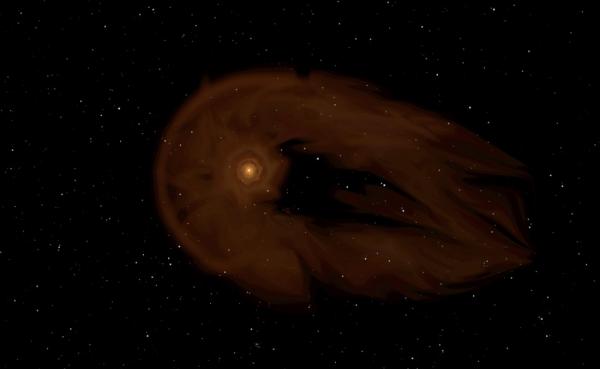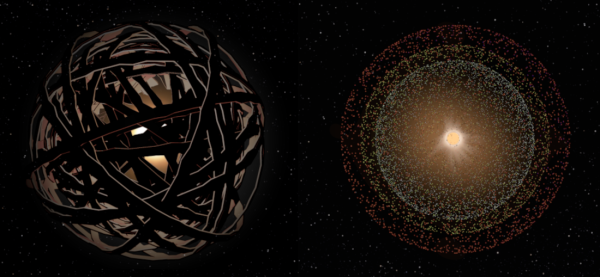BY LETTER
Grenrij
Galactography > Regions of Space > Middle Regions/Hinter-regions
Galactography > Systems and Worlds > Systems & Worlds G - H
Galactography > Systems and Worlds > Systems & Worlds G - H
CW Leonis - a runaway carbon star 433 light years from Sol | |
 Image from Trolligi | |
| This large star is embedded in a thick, dusty envelope rich in carbon | |
Grenrij - (CW Leonis): Data panel | |
| System | Name: Grenrij Components: 2 - Grenrij (CW Leonis A)(Big Red) - Azus (CW Leonis B) Location: - Distance from Sol: 433.788 light years (epoch J2000) - Constellation: Leo |
|---|---|
| Stars | Primary: Names: Grenrij, CW Leonis A, IRC +10216, IRAS 09452+1330 Physical characteristics: - Mass: 2 x Sol - Radius: 683 x Sol - Luminosity: 9,800 x Sol (bolometric) - Temperature: 2,200 Kelvin - Spectral type: C9.5 III - Age: 210 million years Secondary: Names: Azus, CW Leonis B Physical characteristics: - Mass: 0.6 x Sol - Radius: 0.56 x Sol - Luminosity: 0.074 x Sol (bolometric) - Temperature: 4,030 Kelvin - Spectral type: K8 V - Age: approx 210 million years Orbital Parameters - Orbital Period: (A+B) 130 years - Semi-Major Axis: 35.3 AU |
| Planetary System | 1) Glatam: Circumbinary HydroJovian GeliJotunnian HydrogoBarian Semi-major axis = 92.62 AU, Orbital period = 552.28 years, Eccentricity = 0.178, Mass = 1656.44 x Earth, Radius = 11.56 x Earth 2) Murkein: Circumbinary HydroJovian GeliJotunnian HydrogoBarian Semi-major axis = 261.96 AU, Orbital period = 2,626.7 years, Eccentricity = 0.122, Mass = 1830.71 x Earth, Radius = 11.43 x Earth 3) Tertassen: Circumbinary AmmoJovian GeliJotunnian HydrogoBarian Semi-major axis = 756.49 AU, Orbital period = 12,902 years, Eccentricity = 0.106, Mass = 146.88 x Earth, Radius = 10.31 x Earth 4) Lugoth: Circumbinary MethoNeptunian GeliJotunnian HydrogoBarian Semi-major axis = 1543.9 AU, Orbital period = 37,621 years, Eccentricity = 0.203, Mass = 23.91 x Earth, Radius = 5.86 x Earth |
|---|---|
| Colonised | The system was first reached in 2698 AT by autonomous probes. |
| Wormhole | Tesselating Streams Hidden in Glimmers to local Relay system |
The Grenrij System - characteristics
Grenrij, also known as CW Leonis, is a binary star system consisting of the eponymous variable carbon star and its companion K-dwarf star located about 434 light years away from Solsys in the constellation of Leo. Grenrij is the closest carbon star to Sol, and would be a naked-eye star from Solsys if it were not surrounded by a thick dusty nebula. It has a relatively high proper motion of 42 km/s. Its name, given by the first colonists of the system, alludes to its extreme size and deep red colouration when observed from afar.Originally a late B-type star twice as massive as its current mass, Grenrij was already in the final stages of the asymptotic giant branch (AGB) phase of stellar evolution when the first Terragen explorers arrived, and will leave the AGB phase in the next few thousand years. As an AGB star, Grenrij exhibits powerful stellar wind ejecting its own mass out into space. An array of stellar wind collection systems have been built around the star to take advantage of this feature by capturing the escaping matter, which is then converted into mattercaches for use in the future. This takes the form of a large dyson structure orbiting Grenrij used to capture its light. The orbits of various elements of this swarm have to be readjusted from time to time as Grenrij's mass continues to shrink. At the centre of the swarm is a starlifting rig, used to redirect mass loss to the poles to be collected.
The elevated amount of mass loss that the star has been experiencing over the last few tens of thousands of years produced a carbon-rich nebulosity enshrouding the star system, known as the Peanut Nebula, and this nebula was a popular subject for artistic works, both by artists within the Grenrij system and in neghbouring systems. Many of these artists objected to the depletion and reduction of the nebula by mining over the next few thousand years, but eventually the Peanut Nebula almost completely disappeared through resource utilisation. This mining was predominantly carried out by the system's transapients, who used it to construct processing megastructures.
 Image from Steve Bowers | |
| The nebula around this fast-moving star formed a distinct bowshock, and was given the label 'The Peanut Nebula' by Terran astronomers. Since colonisation this nebula has been largely depleted by mining | |
Grenrij has a planetary system consisting of four circumbinary gas giant planets, whose orbits have widened significantly due to intense mass loss Grenrij has been experiencing. Lugoth has been extensively mined for resources used to build various types of infrastructure around the system, while the remaining planets were left alone for habitation by modosophonts and lower transapients alike.
Chexthim, the outermost and the largest moon of Glatam, possesses mechologies operating beneath its barren surface, which produce various kinds of luxury goods over time. A significant portion of the local population frequently go on a hunt for these highly desirable items as a recreational activity.
The inner portion of the satellite system around Tertassen was disassembled and incorporated into the Foam Rings, a set of concentric solid ring-like structures, each between a few tens of metres to at most a kilometre wide surrounding the planet, with countless cavernous pores that are inhabited by vacuum-adapted ecologies and sophonts alike. Notably, decorating some of the amorphous walls within the outer portions of the Disks are a series of intricate paintings, almost two-thousand-years-old, made by inhabitants inspired by a popular artist known as 27th Batik Honour who visited Grenrij in 8833.
 Image from Trolligi and Steve Bowers | |
| Tertassen and the Foam-Rings | |
History
Since its discovery during the first century AT, the Grenrij system and the surrounding Peanut Nebula were observed and their characteristics teased out, having attracted a lot of attention due to its status as the nearest carbon star to Solsys. Theoretically a good colonisation candidate as the nebulosity was found to contain dust rich in carbon and the binary stars featured a family of circumbinary giant planets, the great distance meant no colonisation mission succeeded until the late Federation.A number of fast long-range probes and colony missions were launched towards the star starting from the late Federation era. The first of these autonomous probes arrived in the vicinity of Grenrij in 2698 AT, and were able to take the first close-up photos of the star's surroundings, as well as its planets, and map additional small bodies in greater detail. Several more probe missions of various affiliations and designs arrived at the star system soon after, some of which were capable of constructing engenerator stations, among other rudimentary infrastructures within the system, to permit virtual sophont migration as well as prepare the system for the first crewed colony missions which would not arrive until 3100 AT.
The system's enveloping carbon-rich nebula was the centre of a conflict between resource miners and the utilitarian sense that many adopted, and artists and cultures surrounding Grenrij. The large amount of mass-energy that could be found in the Peanut Nebula were travelling outward at a high speed, becoming increasingly difficult to collect every passing moment, but the aesthetic of the nebula itself also contributed significantly to the system's soft power, and its decimation and removal threatened souring relations with Grenrij's neighbours. Thus, the early mining operations of the Peanut Nebula were frequently hampered by resistance from various groups, which took the form of protests, memetic attacks, and legal warfare. Over time, transapient development of the star starved the Peanut Nebula of illumination and constant addition of fresh new matter to perpetuate its existence, which in turn gradually eroded the resistance and allowed large scale mining operations to prevail.
 Image from Steve Bowers | |
| Left to right: Grenrij Dyson Structure, Azus Matrioshka Brain | |
Culture
Although thousands of other subcultures and hobbies exist in the system, within the past few centuries, many Grenrij Societies have become unusually fixated around astronomy and astronomy-related activities as a primary trend. People are named after astronomical objects, astronomy-related constructs, and dates of significance revolve around aspects of astronomy such as the discovery of celestial objects or concepts. Many astronomers in Grenrij choose to process astronomical data directly from the local observatories by using their neural implants to identify interesting patterns in the mountains of astronomical data they receive from the many nearby purely recreational telescopes.After the Peanut Nebula's disintegration, those who had wanted to keep it and see an end to the mining which was depleting the nebula had lost hope and experimented with other ways of viewing celestial objects, most notably simulating their own night skies in their habitats using holograms and optical phased arrays as a way to cope with the loss of the nebula. At first nebulae were almost exclusively modeled after existing astronomical objects but as time went on, more fictional or fantastical objects became more popular to display.
This drew in a large number of astronomers and astronomy enthusiasts from the surrounding area, which made Grenrij a hotspot of astronomical activity. Many started to base their work in Grenrij's habs, converting each orbital band to resemble the structure of a telescope by coating their hulls with optical phased arrays. Orbital bands around the dwarf planet Puramuza have been used to construct rudimentary space probes, which have been launched at specific targets of interest nearby, including a nearby rogue planet which was found to harbour an ecosystem of extremophile vacuum organisms left over from transapients who had passed through the region, centuries before.
Due to Grenrij's high concentration of astronomers, many space habitats have been optimised for observing stars, which includes flattening them from a cylinder shape to a disk shape to maximise external hall and window space, and so viewing the night sky which facilitates observations. Habs also face the exact same way so that the circular sides of the disk are not obscured at all, and only a small part of the sky remains out of view. This changes periodically as the habs orbit Grenrij. Grenrij's habs have also minimized external light usage and pollution, in order to maximize the locals' direct stargazing.
Related Articles
Appears in Topics
Development Notes
Text by Trolligi
Additional material by Worldtree and Steve Bowers
Initially published on 28 January 2024.
References
[1706.04391] Evidence for orbital motion of CW Leonis from ground-based astrometry (arxiv.org) (orbital period of ~130 years)
New light on Galactic post-asymptotic giant branch stars - I. First distance catalogue - NASA/ADS (harvard.edu)
(luminosity and distance of primary)
Time-dependent molecular emission in IRC + 10216 - NASA/ADS (harvard.edu)
(temperature of primary)
ALMA data suggest the presence of spiral structure in the inner wind of CW Leonis - NASA/ADS (harvard.edu)
(mass of secondary)
Additional material by Worldtree and Steve Bowers
Initially published on 28 January 2024.
References
[1706.04391] Evidence for orbital motion of CW Leonis from ground-based astrometry (arxiv.org) (orbital period of ~130 years)
New light on Galactic post-asymptotic giant branch stars - I. First distance catalogue - NASA/ADS (harvard.edu)
(luminosity and distance of primary)
Time-dependent molecular emission in IRC + 10216 - NASA/ADS (harvard.edu)
(temperature of primary)
ALMA data suggest the presence of spiral structure in the inner wind of CW Leonis - NASA/ADS (harvard.edu)
(mass of secondary)






